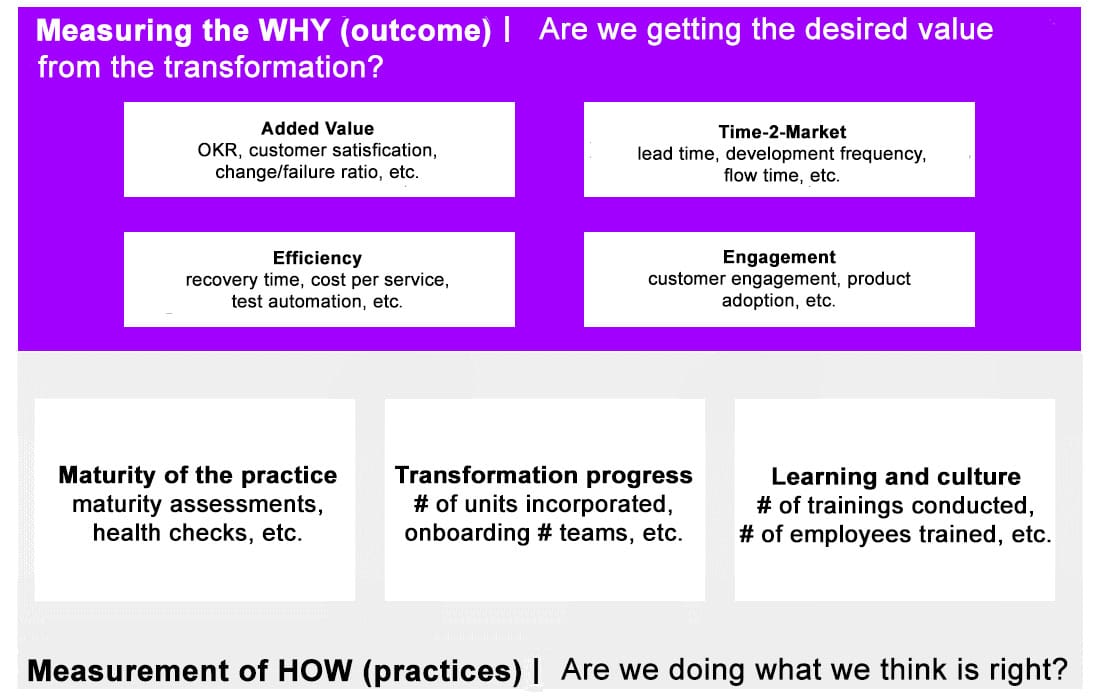Overcoming challenges in stagnant transformations
Expand the table of contents
“Transformation guidance needs to derive change actions more from what value is being delivered and move away from blindly introducing methods.”
In our daily work at Accenture Business Agility, we increasingly find that many organisations realise that agile transformations are stagnating. In this context, we observe three key challenges: The first challenge deals with how organisations proceed during an agile change project. Here, patterns and commonalities can be identified across different industries and company sizes. Furthermore, the value proposition of the intended change and the measurement of progress are neglected, although this is a central success factor. And finally, there is still a gap between “Doing Agile” and “Being Agile”.
In the following, we take a detailed look at the individual challenges of stagnating transformations and go into corresponding solution measures.
Challenge 1:
Comparable patterns of different organisations during an agile transformation
A large number of organisations follow a comparable path on their agile transformation. They start with a wild phase of experimenting with agile methods, in which above all awareness is built up and basics are established, broad and multi-layered practice is carried out, and a lot is learned. The initiative and approach is bottom-up and is controlled and shaped by a few.
This wild phase ends in a tipping point where top management support is won and a phase of acceleration is ushered in. In this acceleration phase, the target picture of change is defined, pilots are then launched and scaling is driven by a transformation team. The second phase is characterised by the formation of agile teams and teams of teams.
Figure 1: The four typical phases of an agile transformation
The second phase is achieved through two drivers in particular:
- Firstly, through the support of top management, which has recognised agility as a value-creating initiative,
- secondly, through professional accompaniment and management of the change.
Professional transformation support in particular often leads to the change being approached more consistently and seriously.
The third phase is characterised by the holistic introduction of agile ways of working in an entire organisational unit and the expansion of agile teams or teams of teams. The value proposition established in the second phase and professional support play a central role here – only with adequate and targeted coaching will the leap succeed.
The fourth and final phase is characterised by the consistent expansion of agile working methods into the entire organisation.
Note: Agile frameworks and their use
In our environment, the majority of companies use the Scaled Agile Framework SAFe for their agile transformations. There are a number of reasons for this, but the most important seems to be the easy access to coaching, training and tools in using SAFe. Furthermore, various organisations have developed their own frameworks, but have closely followed SAFe and adopted individual aspects. Large Scale Srum (LeSS) and Scrum of Scrums were used to some extent, but only in individual areas and not across whole organisations.
Challenge 2:
The value proposition lacks depth and the measurement of agile transformation is still in its infancy
Despite existing target images for agile transformations, many cases lack a clear value proposition on the one hand, while on the other hand measuring the results is neglected across the board. This combination of a poor value proposition and non-existent metrics leads to a realisation after two to three years: companies realise that their focus was on how well a methodology or framework was introduced in the organisation, and not on what added value they achieved with it.
Measurement provides guidance and a reference on what the change is meant to improve for the better. When organisations forget to measure a transformation, it either becomes an arbitrary change because they do not know what they want to improve, or the transformation focuses on the introduction and implementation of a methodology.
In order to be able to start measuring, three success factors are relevant, but before that it must be possible to derive what is to be achieved with change via the value proposition, e.g. acceleration of time-2-market, increase in customer satisfaction, etc. This is an important prerequisite to be able to start measuring. This is an important prerequisite to be able to start measuring at all.
Figure 2: The different measurements between the why and the how
A second success factor is to try to measure outcomes from the beginning. Most metrics cannot be directly influenced, so it is important to talk about what outcome should be produced.
The third success factor is that concrete actions are derived from the metrics and the reporting, i.e. from the measurement. For example, the Problem Solving Workshop in SAFe offers a great opportunity to develop data-driven improvement features for the project itself and then implement them. Implementation is successful when the improvement features are planned in the backlog, ranked and pulled by the teams.
The last point in particular can often be observed in practice when the “why” of the change has not been clearly and comprehensibly defined. The discussion focuses on the question of whether the scaling framework (e.g. SAFe) was implemented correctly. The intended effect is not considered. With the methodological focus, the question of what an organisation needs to do differently in order to continuously improve the manufactured added value of the transformation also remains unanswered.
A key advantage of measurement is that with concrete data and facts, collaboration between business and IT can be initiated more easily. A change driven by IT must be able to demonstrate to the business that a positive change is associated with the transformation. Finally, measurement creates a data-driven feedback loop that helps the transformation, the organisation and the employees to continuously improve.
Challenge 3:
The culture change has an impact on transformation support
We observe again and again that the focus of an agile transformation is to produce a uniform implementation and methodological application in the organisation. Change work in this context means passing knowledge from SAFe, a self-produced playbook or from a PowerPoint slide into the organisation.
Agile coaches thus explain to the employees how the new way of working works and help them to implement it correctly. After one to two years, the employees have understood the change and adopted those things that they consider positive and value-adding. At this point, many companies then stagnate because the organisation has reached the status of “Doing Agile”. Agile methods and practices have been implemented, but the desired added value has not yet been produced. At this point, the requirements for transformation support change significantly.
Figure 3: The basic building blocks for agile culture development
How can the challenges described be addressed?
There are three points that organisations can use to address the challenges described:
- Firstly, the foundation, i.e. the value proposition, must be provided in adequate form and depth. This means that the value proposition must make it clear what added value an agile transformation is supposed to achieve.
- Secondly, the measurement of change on the basis of the value proposition must always be outcome-based. In addition to focusing on outcome-based metrics, it is better to start measuring early and then continuously improve them.
- Thirdly, organisations need to realise that agility is not a mindset and that without a holistic cultural view, the leap from “Doing Agile” to “Being Agile” will not succeed. So an organisation needs to understand what phase of transformation it is in and anticipate the change in transformation support requirements.
Notes:
This is a joined article by Dr Joël Krapf and Jannick Gerber. If you like it or want to discuss it, feel free to share it in your network.
Dr Joël Krapf has published two more posts on the t2informatik Blog:

Dr. Joël Krapf
Dr Joël Krapf has been supporting corporate transformations for over 10 years. He currently supports organisations on their digital journey as a senior manager at Accenture. Previously, he was Head of Lean Portfolio and Agile Transformation at Migros, the largest employer in Switzerland. Other positions include PwC and Swiss Post.
Joël holds a PhD in Agile and Transformation from the University of St. Gallen. He has published various books and articles on the topic of agility and is regularly invited as a keynote speaker at conferences. Around 30,000 people follow him and his posts on LinkedIn.

Jannick Gerber
Jannick Gerber has been accompanying transformations of companies for more than 5 years. He currently supports organisations in their digital transformation as a manager at Accenture. Previously, he was active at Migros as Senior Transformation Manager and Deputy Head Lean Portfolio & Agile Transformation. Jannick holds a BSc. in Business Administration from the University of Applied Sciences Fribourg and an MSc. in Business Administration from the University of Applied Sciences Bern.
In the t2informatik Blog, we publish articles for people in organisations. For these people, we develop and modernise software. Pragmatic. ✔️ Personal. ✔️ Professional. ✔️ Click here to find out more.




